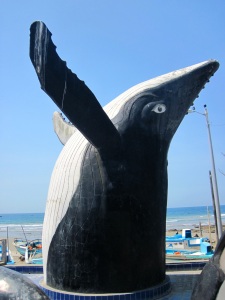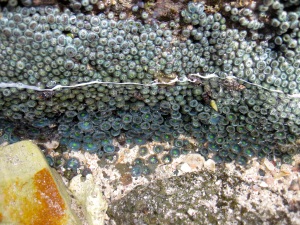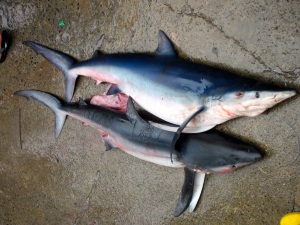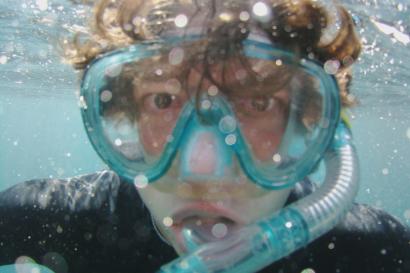We returned from the coast last night, skin warm and with smiles on our faces (which is saying something after ~15 hours of travel). The trip was incredible! I had never even thought much about the coast of Ecuador, but it was so beautiful that I hope to return one day.
The trip began with a 10 hour bus ride through what seemed like every imaginable habitat (excluding the poles of course!) We went through rain forests, banana plantations and deserts to end up at the sea.
This is the view from the bus on the way down from the Andes.
We ended up at the coast just in time for sunset.
Our first two nights were spent in Puerto Lopez (above). The town was covered in signs about whale watching and a whale festival (?!?!?!?!?!?!) that is in the summer.
We didn’t see any whales this trip but maybe in the future I will return to go to the festival.
Our days were spent in the intertidal zone conducting various research projects. In the afternoon we swam, hiked and traveled, and at night we entered our data, relaxed or went dancing.
One research project was weighing and measuring whelks to look at size demographics in relationship to beach accessibility.

Another group worked on identifying the number of invertebrates and percent algae cover of each tide zone.
I worked with one of the master’s students looking for this sea star (Heliaster cumingui) that is found on the coast of Ecuador and in the Galapagos Islands. It is becoming rare in the Galapagos because it is susceptible to El Niño events. We measured each sea star we found and recorded its habitat. For our project we will write a research proposal looking to identify its microhabitat, while the other groups will add their data to an existing set and write papers answering the questions of their choice.
I was so fun to search for the sea stars and I got to find all kinds of other animals as well!
Multiple species of zoanthids covered some of the beaches we went to. My favorite were these blue ones that made the tide pools look like jewels.
All of the beaches had these black sea urchins that looked far more dangerous than the green urchins in Washington!
This is a perfect sea urchin test that we found in the rocks.
I loved these funny Nudibranchs! The rocks were also covered in the cutest sea slugs that people call the cows of the sea, but I couldn’t get a good photo of them (when camouflage works to well…)
We also found these Ascidians. They don’t look like much, but they are our invertebrate cousins!
These are two sea turtle plates that were found under some rocks.
Climbing this rock was a challenge as it was covered in sharp barnacles and urchins!
The beaches were so beautiful. Here are a pictures of a few of them.
Machachilla from the view point above.
Me on top of a cliff (and next to a cliff) in La Playita.
La Playita from afar. It was about a 20 minute hike to the beach!
For this class I have two professors: Maggie and Louis. Both of them are intelligent and fun. For Maggie’s birthday we all went to Montañita. Normally I would avoid a town known for partying tourists like the plague, but in the spirit of trying new things I went. It was fun to dance and experience the night life! My other professor Louis brought his Golden Retriever on the trip. Her name is Maura and she brought so much happiness to the group and the people we met!
Here is Louis and Maura getting love from two Ecuadorian girls.
One of the most interesting parts of the trip was going to the fish markets. We woke up early to go in Puerto Lopez and Salinas and learn about by catch in Ecuador. Recently the laws regarding shark by catch have changed, making it legal to sell shark fins and meat if they were caught accidentally. Although ideally regulations would be implemented to keep sharks from being caught at all, but this law allows fisherman who were once accidental criminals to be businessmen.
A warning that some of these photos are a little bloody but not too bad. Welcome to the fish market!
The fishermen bring their boats to shore, unload their catch and after selling a fish, cut it up.
Here are some sting rays that have had their heads and tails cut out.
A shark and a ray, ready to sell.
In less than a week this shark would have given birth to over 15 pups. Instead, this man cuts them out of their mother and throws them in the waste bin.
Two sharks on the beach in Puerto Lopez
A boat full of Sward Fish in Puerto Lopez.
A Salinas fisherman standing on the head of a Sward Fish.
Two Blue Sharks in Salinas.
Going to the markets was definitely a cultural experience. It is hard to know what to think of them.
Frigate birds swarm overhead contributing to the commotion and eating the leftovers.
Here is the Puerto Lopez market from the pier.
On our final full day on the coast we went on a diving/ snorkeling trip. Since I don’t dive yet, I snorkeled and honestly it wasn’t the best snorkeling I have ever done. The water was rough and the rocks were pretty deep, but it is always fun to get in the water and look around!
A school of fish.
When one of the guides pulled an octopus out of the rocks, I was excited to see it and then worried as it encased his arm. I swam over to get a closer look only to see him pulling its head apart with his hands. Just another shocking cultural difference I guess, although people probably do that in the States as well.
The amount of trash not only on the beaches but covering roadsides on our way to the coast was astounding. We take for granted the ability to have trash collection in the US.
The beaches were covered in plastic waste, a reminder that we need to reduce our consumption, recycle and figure out a way for people in countries like Ecuador to do the same.
Overall the trip to the coast was a success and I am so glad I went!
I will leave you for now with a beautiful sunset in Puerto Lopez. In less than two weeks I will be in the Galapagos. Today we road the Teleferico in Quito, this weekend we are going to Los Baños and next week we have projects, exams and papers to write. Phew, a lot to do!










































